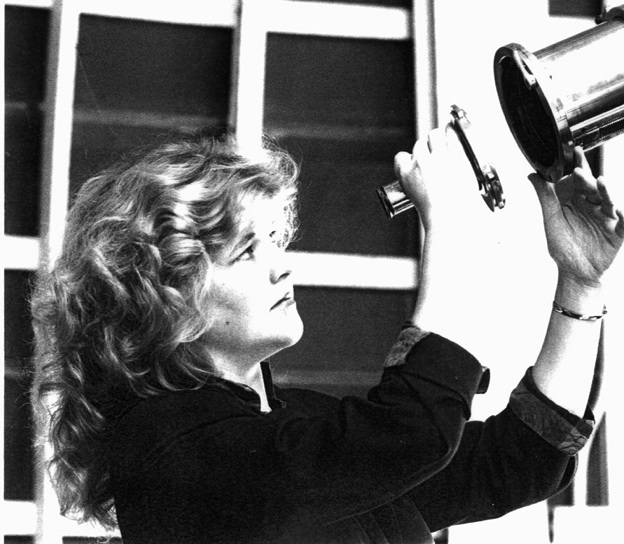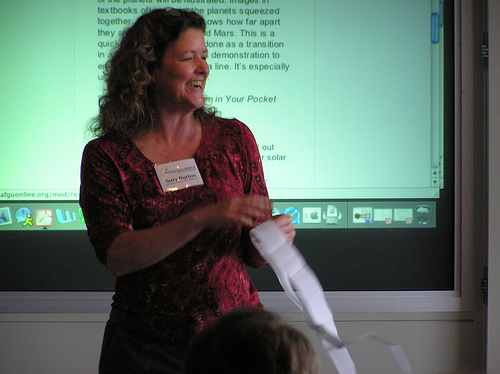 Ask Suzy Gurton, Education Manager at the Astronomical Society of the Pacific, about hands-on astronomy, and you’ll be disabused of any notion that studying the cosmos need be a solely intellectual pursuit.
Ask Suzy Gurton, Education Manager at the Astronomical Society of the Pacific, about hands-on astronomy, and you’ll be disabused of any notion that studying the cosmos need be a solely intellectual pursuit.
She’ll remind you that building your own telescope is very hands-on, as is experimenting with colored filters and simple spectroscopes to understand how images from telescopes like the Hubble are created.
But Gurton really waxes eloquent when you get her on the subject of models. “You can’t build a star,” she says, “but you can build a model of a star, and you can model the universe.”
It’s two hundred toilet paper squares to Pluto
One of her favorite model-building activities is the Toilet Paper Solar System. “It may start as a sort of gag–kids love bathroom humor, and they get to thinking about doing a TP job on their classroom–but this activity has so much to keep them busy counting and labeling that they never get the chance to get into mischief.”
 The activity, however giggle-inducing, actually teaches something quite profound: that the common grade-school model of the universe, with planets equidistant from each other, is a serious misrepresentation. “By the time the kids are done,” says Gurton, “they see just how “crowded” the inner solar system is and how much space is between the outer planets.” In fact, you need 200 toilet paper squares (this activity’s unit of measurement) to get out to Pluto! Yes, Pluto has been demoted (I hate that term! says Gurton) to a Dwarf Planet, but we have such a long-standing relationship to that celestial body, we’re loath to exclude it when we model the non-dwarf planets.
The activity, however giggle-inducing, actually teaches something quite profound: that the common grade-school model of the universe, with planets equidistant from each other, is a serious misrepresentation. “By the time the kids are done,” says Gurton, “they see just how “crowded” the inner solar system is and how much space is between the outer planets.” In fact, you need 200 toilet paper squares (this activity’s unit of measurement) to get out to Pluto! Yes, Pluto has been demoted (I hate that term! says Gurton) to a Dwarf Planet, but we have such a long-standing relationship to that celestial body, we’re loath to exclude it when we model the non-dwarf planets.
“Introducing this activity is great fun,” Gurton notes. “I’ve seen one of our volunteers do it in a classroom where he first goes through the order of the planets from the sun, then goes on and on about the difficulty of developing a scale model of the orbits of the planets and how it requires a very special “chart paper.” Finally he pulls that special chart paper out of his shopping bag, and it’s a roll of toilet paper! It gets a laugh every time.”
Gurton cautions that you need a lot of indoor space to do this activity–enough to spool out an entire roll of toilet paper. And since toilet paper is delicate and tears easily, doing the activity outdoors can be a challenge.
 A kid-sized universe, and bringing math to the table
A kid-sized universe, and bringing math to the table
Not enough room indoors to unroll an entire roll of toilet paper? Try the Pocket Solar System activity. Kids create a solar system (with adding machine tape) that is as big as they are, then are able to fold it up and put it in their pocket. Math can be emphasized or deemphasized depending on your audience–the Pocket Solar System is perfect for teaching fractions, if the kids are ready for that.
“It’s always an interesting mathematical exercise to try to develop a scale model of the orbits of the planets,” says Gurton. “But quite frankly the math can be intimidating to some. I love models because you can either start with the math or skip it,” providing learners with the numbers. The challenge then is in actually building the model, and learners still get to have a kinesthetic experience of the scale of our universe.
An inclusive science
Beyond its connections to math, “the science of astronomy is so wonderfully inclusive,” Gurton notes. “It has connections to all other sciences. In looking at the formation of planets, you can look at the conditions necessary for life. Through the study of stellar evolution, you get both thermodynamics and nuclear physics. The laws of physics we’ve figured out here on Earth can be applied to places we’ll never be able to go. And one of the most profound repercussions of the space program was seeing our planet from afar, being able to look back at how fragile and tiny it really its. This new point of view helped launch the environmental movement.”
Another thing Gurton loves about studying astronomy, she says, is that it gives you a “tremendous sense of place–in both space and time.”
Photos of Suzy Gurton courtesy of Suzy Gurton.
SMILE’s September 2010 eNewsletter is dedicated entirely to astronomy. Sign up for the newsletter.
Visit howtosmile.org.



* You can follow any responses to this entry through the RSS 2.0 feed.